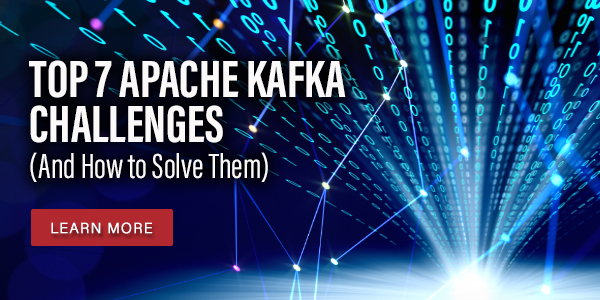Apache Kafka is now the official gatekeeper of streaming data. It’s a distributed data store designed and perfectly calibrated to ingest and process streaming data (ie, data continuously generated by thousands of sources) in real time.
As both the amount and value of streaming data rapidly grow, it’s becoming increasingly important for companies to start using Kafka to their advantage by fully optimizing its capabilities.
But what exactly are Kafka’s capabilities and what is Kafka best used for?
We’ll explore that now.
Here are the top five Apache Kafka use cases.
Table Of Contents
1. Messaging
One of Kafka’s best and most common use cases is as a messaging queue.
Kafka gives you a reliable and scalable message queue that can handle huge volumes of data. If you’re a microservices developer or architect, then you understand why establishing a reliable but loosely coupled communication between your services is so important: You want your services to produce and publish data to the world without increasing your system’s complexity. Kafka allows you to do that. You can organize your messages into “topics”, meaning you publish each message to one specific topic, and on the other side the consumers will subscribe to one or more topics and consume messages from them.
As an example, imagine you’re running a big e-commerce platform and you want your users to register an account before buying anything. For each registration, you would publish an event to Kafka with the registrant’s ID, name, surname, address, etc… After the event is published, various consumers might be interested in this information and find it useful. For example, the “cart” service might be interested in the registrant’s information to create an empty cart for that user. Maybe the “marketing” service wants to send some real-time offers to newly registered users. Or, maybe the “notifications” service wants to send a welcome email to make users feel at home.
The greatest advantage of decoupled communication between microservices is that you can add new services to those events at any time without increasing the system’s complexity or having to change any source code.

2. Stream processing
Another great Kafka use case is real-time stream processing applications, which can process, analyze, and transform streams of data in a fraction of a second. These applications alter the events going through Kafka, aggregate them, and calculate sum, average, max, min, etc., grouping events in moving windows to, for example, get aggregations every five minutes.
This is especially useful for time-critical applications like fraud detection, real-time analytics, or IoT data processing. Kafka gives you various interfaces you can use to implement your logic. Apart from the low-level producers and consumers, which give you the most flexibility but require you to implement the majority of stream processing yourself, Kafka gives you a client library called Kafka Streams that enables you to easily “map” messages, count them, calculate sum, and get averages over different window variations. You can do that in your own service using Java.
3. Event sourcing
If you make the events a first-class citizen (ie, source of truth) in your system, then storing your application’s state is a series of events and everything else in the system is recomputable from those durable and immutable events. Event sourcing is all about capturing the changes to state in a series of events. Companies typically use Kafka as their primary event store. In the case of any failure, rollback, or need to reconstruct the state, you can just reapply the events from Kafka at any point in time.
This is extremely useful for applications that require a good explanation about changes in state: you can just inspect the changes and see who did what or what caused some situation. Furthermore, if you inadvertently introduce a bug to your application, which results in an invalid state, you can just fix the code, deploy it, and reconstruct the state from an immutable change log.
4. Real-time clickstream analysis
Another great Kafka use case is real-time clickstream analysis. Running an online business usually requires you to gain insights about your users’ activity on your site. You can use Kafka to collect that clickstream data in a scalable, fault-tolerant way and get the real-time data on your user behavior and preferences.
You can aggregate, join, or alter all that information to detect patterns, anomalies, or trends, which will enable you to serve up hyper-personalized recommendations in real time to currently browsing users or to detect a hacked account and block it before any confidential information is compromised.
5. Data pipelines
Finally, Kafka is also a great tool to build your data pipeline, meaning you can use it to ingest data from various sources, apply your processing rules, and store the data in a warehouse, data lake, or data mesh. You can leverage Kafka Connect to integrate Kafka with other data pipeline components in your system, such as Apache Hadoop.
Kafka Use Cases: Beware of these Challenges
Kafka has proven itself as an invaluable and indispensable tool for capitalizing on streaming data. But, whether you’re using Kafka for messaging, stream processing, event sourcing, real-time clickstream analysis, or data pipelines, you are likely to start to run into certain challenges as you scale your use of Kafka.



